How to Write a Digital Marketing Proposal

Creating a digital marketing proposal is like making a first impression. It must captivate at first sight and leave an aftertaste of confidence in your professionalism. Your proposal should integrate the client's needs with your experience and knowledge. The key to a successful deal is the proper structure, a clear statement of values , and the ability to achieve results.
This comprehensive article will help you explore all the intricacies of the process - from the analysis of the customer's needs to the vivid presentation of your solutions. By applying our expert tips, you will be able to create unique and effective offers that will break new ground in digital marketing.
Understanding the client’s needs
Analyzing customer needs is the foundation of a successful digital marketing proposal. This step depends on how well you can adapt your strategies, resources, and solutions to the real challenges of the client's business. Instead of using a one-size-fits-all solution, tailoring an offer to fit a specific business greatly boosts the chances of success.

Step 1: Collect customer data
This includes studying the client's business model, product or service features, mission, values, and long-term goals. Do not be afraid to ask questions to the customer - the proposal's success will depend on the clarity of understanding. Below are several examples of questions that might help:
What critical results does the client expect to achieve through digital marketing?
Which channels does he consider to be the most productive?
Has the client had negative or positive marketing experiences in the past?
This information allows customers to understand the business goals and potential obstacles they may face.
Step 2: Identify the client's pain points and needs
The next level of understanding the client's needs is identifying pain points. Knowing these points makes it possible to formulate a digital marketing offer as a solution to specific problems rather than simply describing your services.
For example, if the client encounters low-effectiveness advertising campaigns, this can become an essential focus for your offer. You'll be able to demonstrate how your approach to ad analysis and optimization will help you improve clients’ key performance indicators (KPIs) and return on investment (ROI).
Step 3: Adapt services to the specific goals of the client
Once you've gathered enough information about the customer and their needs, move on to tailoring your services to those specific goals. Your proposal should be not just a list of possibilities but a logical sequence of steps to solve the specified problems. Demonstrate how your tools, teams, or resources can contribute to the client's goal.
Let's say a customer wants to increase engagement through a social media marketing proposal. In this case, you should explain in detail how you plan to use the relevant channels, what tactics you will use to increase engagement, and what the expected results will be.
Step 4: Use individual approach and personalization
One of the most powerful tools in building a successful digital marketing proposal is personalization. Highlight the client's uniqueness and show that each proposed step is explicitly designed for them, taking into account the specifics of the business. If the customer sees that your offer is "made for them" and not a one-size-fits-all scheme, it will significantly increase their trust and interest.
Emphasize that your team will work on individual tasks, adapting them to market requirements and dynamics. Confirm this with specific examples or cases that prove the effectiveness of such an approach.
Step 5: Utilize data to prove the value
Comprehending the customer's needs is also about demonstrating how your offerings create value. This is where the use of data will come in handy.
For instance, you can use case studies of previous clients with similar needs, showing positive changes in metrics that can be expected. The data will help the client visualize a specific outcome and assess how exactly your actions will lead them to the desired results.
Crucial components of a digital marketing proposal
Delivering a solid and compelling digital marketing proposal example is essentially the art of presenting your action plan in a clear, organized way. On the other hand, to attract the client's attention and inspire cooperation, each of its components must be thought out and meet the business's specific needs. We offer a structure that will help you make the proposal informative and attractive to the customer.
Below, we prepared the main components of an effective digital marketing proposal.
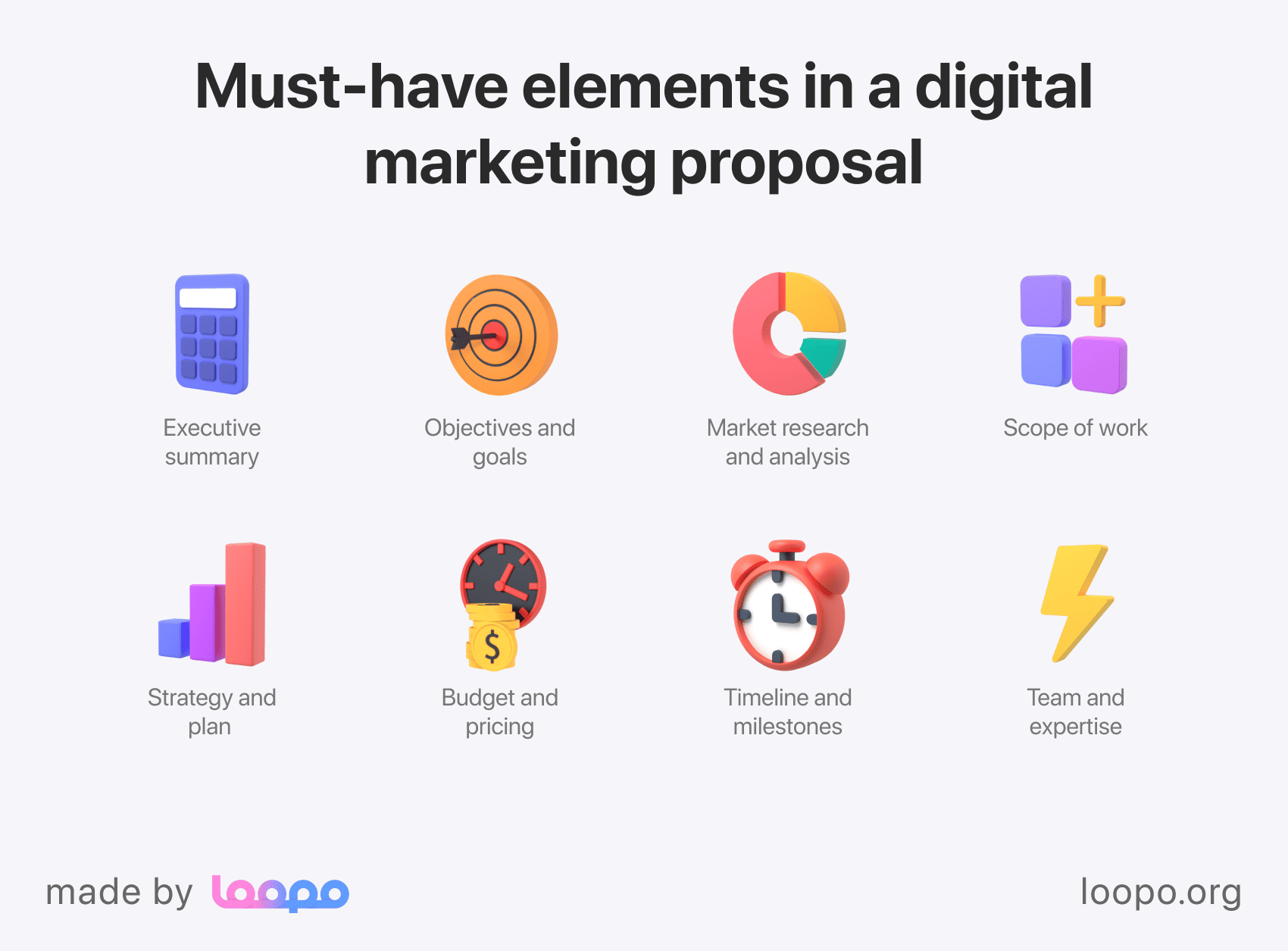
1. Executive summary
In fact, the summary is the first impression you make on a client, so it should be clear, engaging, and as informative as possible. In this section, you should briefly summarize the entire digital marketing proposal template:
The key idea;
The main strategies;
The results the client can expect;
A brief description of how they will be achieved.
Try submitting this part as a solution to the customer's problem. For instance, if a client has a problem with low reach, emphasize that your methods and strategies will help reach a wider audience and boost brand awareness. The client should feel that you understand his business and will be able to help them achieve a new level.
2. Objectives and goals
In the objectives block, you outline the specific results you plan to achieve with digital marketing. So, it is better to use the SMART approach: goals should be specific, measurable, achievable, relevant, and time-bound.
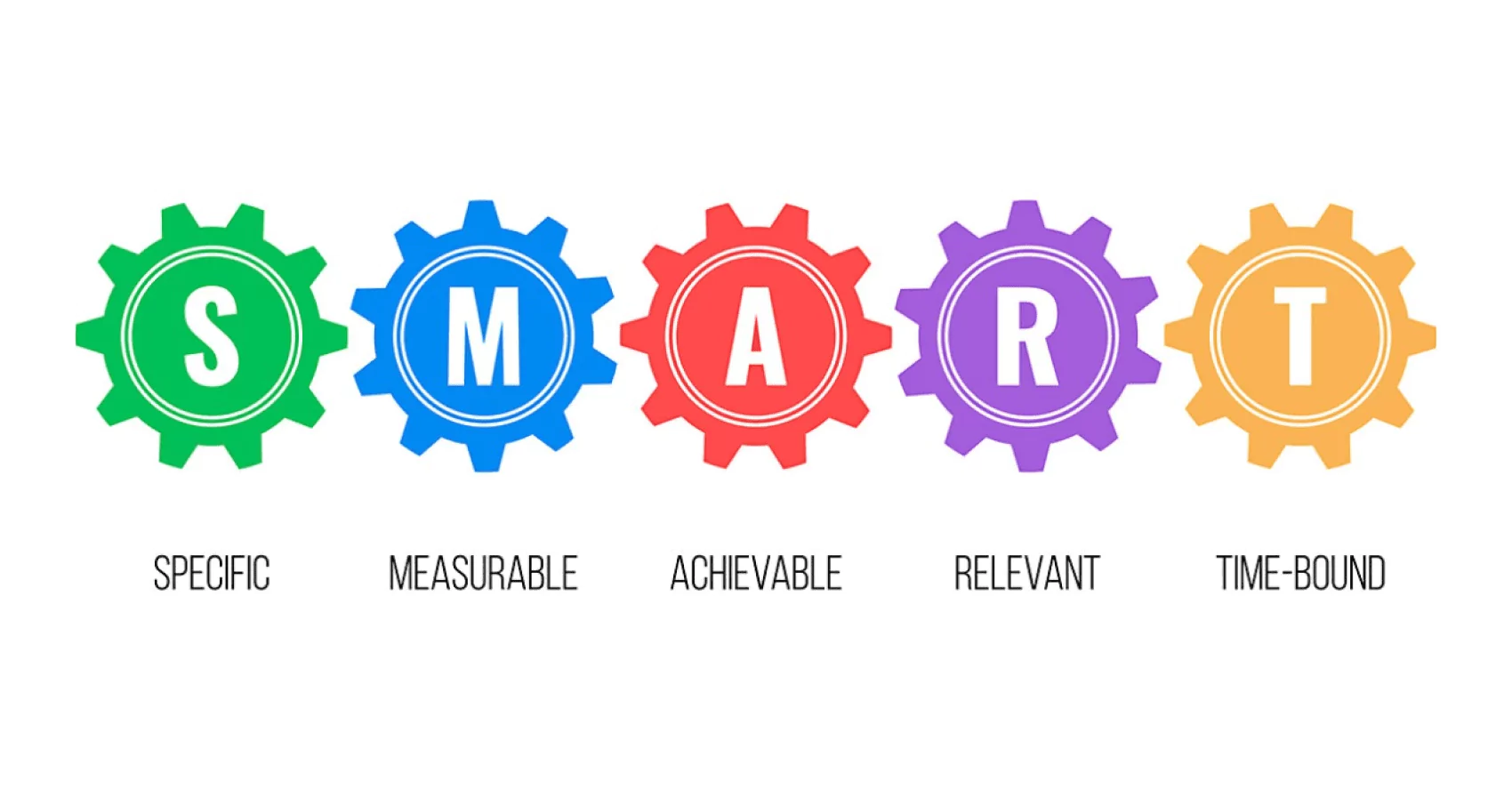
For example, if the client's goal is to increase traffic to the site, you can set a goal to increase the number of visitors by 20% in 6 months. Sharing your goals demonstrates your ambition and competence and helps the client feel that your efforts will produce concrete results.
3. Market research and analysis
In fact, market analysis is one of the most essential parts of a digital marketing proposal sample, and it displays your ability to act on data and understand market conditions. In this section, you display a deep understanding of the client's niche, target audience, and main competitors.
Analyze the client's strengths and weaknesses compared to competitors and identify key market trends, areas of potential growth, and threats. It may also cover research into the target audience's behavior, demographics, interests, and habits. Through this analysis, the client will see that you can make informed decisions and develop strategic plans based on facts.
Read also: Content Strategy Framework that Works: Main Steps to Create
4. Scope of work
In the digital marketing offer, the scope of work is a block where you explain in detail exactly what services will be provided as part of the project. Here, you should clearly define each stage of the work and indicate what resources will be used to complete the tasks.
This section helps the client understand exactly what they are getting and gives them confidence that all aspects of the project will be completed according to plan. For example, if you offer SEO (search engine optimization), content marketing, and social media advertising services, it's vital to describe each of these elements, their tasks, and the results you can expect.
5. Strategy and plan
At this stage of creating an effective digital marketing proposal, you detail your action plan and overall strategy. What tools and methods do you plan to use to achieve your goals? How will you integrate different channels of digital marketing (SEO, SMM, content, advertising) into a single effective mechanism?
It is important to structure this section so that the client can see the logic and consistency of your approach. For example, suppose the goal is to increase brand awareness. In that case, your strategy might include:
Creating visually appealing content.
Increasing the frequency of social media posts.
Launching advertising campaigns aimed at new audiences.
Subsequent retargeting.
6. Budget and pricing
A clear and transparent explanation of the budget is the key to trust. The section "Budget and prices" should be detailed, describing each cost element. Divide the total cost into specific steps or services so the client understands exactly what he is paying for and how each investment will work for the result.
For additional convincing, you can add several options for the digital marketing offer (basic, standard, and premium) so that the client can choose the optimal package of services for them. A transparent approach to budget formation creates a sense of professionalism and provides confidence that the project will be implemented without unforeseen costs.
7. Timeline and milestones
Setting a precise timeline and project milestones helps the client see when and what results they can expect. Here, you define the main phases of the project and set specific dates for their achievement. This allows you to assess the pace of work and clearly shows that your approach is structured and well-planned.
This section of digital marketing proposal may include initial setup, campaign launch, performance monitoring, optimization, and final report. This approach also helps maintain clear communication with the customer, which increases customer satisfaction and reduces the risk of misunderstandings.
8. Team and expertise
In this section, it is important to emphasize who exactly will work on the project. Describe the critical team members, their experience, skills, and roles in the project. This step helps the client understand that real experts with the necessary knowledge and skills are responsible for their project.
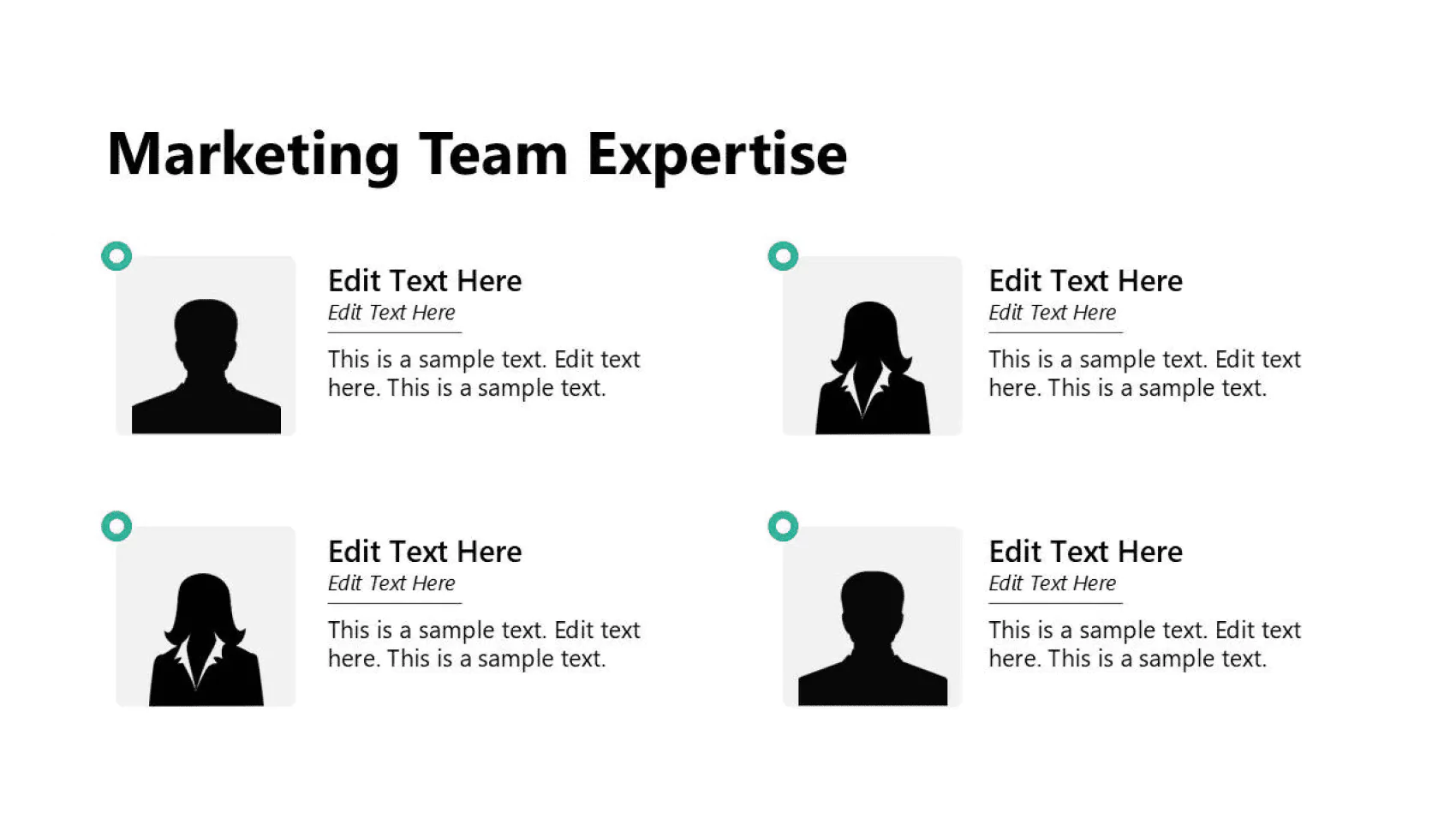
Include examples of past projects or clients you've worked with to highlight your professional experience. Mention achievements that demonstrate your expertise and effectiveness - this will improve the client's level of trust and interest in working with you.
Customizing the digital marketing proposal
Your digital marketing proposal should reflect value, a deep understanding of the client's needs, and the ability to solve their specific problems. Let's check how to deliver these points in more detail.
Tailoring the proposal for the client
Tailoring your digital marketing proposal template to a specific client shows that you are attentive to their needs and willing to spend time creating a personalized strategy. Research before making a proposal allows you to better understand the customer's business, market, and competitors.
For example, instead of simply offering "SEO improvement" as a general service, you can describe in detail exactly how your company will improve the ranking of the customer's site, which keywords will be targeted, and why exactly this is important for his business.

If the client specializes in e-commerce, it's worth emphasizing that your strategy aims to increase conversions through social media or expand your reach with content marketing. This will give the client the sense that you have carefully researched their market and have a vision that will help them stand out from the competition. The more details you add that resonate with the client's individual business objectives, the stronger the digital marketing proposal will be.
Personalizing language to align client’s brand and goals
Among effective digital marketing proposal examples, personalizing your pitch is another vital customization element that helps establish rapport and get your main ideas across. If the customer's brand is focused on innovation, use language that emphasizes your ability to offer modern, creative solutions. If the client's business is aimed at traditional values, the language can be more classical, focusing on stability and reliability.
After analyzing the client's brand, identify key areas of focus that best fit their strategy. For example, for a startup that is just beginning its activities, you can focus on rapid development and building a long-term presence on the Internet. At the same time, large companies that want to maintain a high level of audience engagement are more interested in sophisticated omnichannel marketing strategies.
Thanks to such personalization, the client understands that his needs and goals will not be lost in the general flow of your activity. You show that you really believe in his brand and know how to convey that through your marketing decisions. Using keywords and phrases that match the specific terminology of the client's industry also helps establish a deeper connection because the client feels that you understand their business inside out.
Read also: Content Marketing for Startups: Low-Budget Strategy To Scale
Offering solutions for unique challenges
The best digital marketing proposal should always contain specific solutions that accurately reflect the client's individual challenges. Generic solutions can be perceived as banal and ineffective, while specific proposals built on the basis of analytics inspire more trust. Identify the customer's most pressing challenges and provide easy-to-implement solutions to address them.
For example, if a client is experiencing a low conversion rate on their site, offer to integrate A/B testing, improve the user interface, or create custom landing pages. Show how these actions can affect conversion rates, and justify each of them with analytical data and case studies.
Another example would be developing a marketing automation strategy for a business looking to reduce the cost of acquiring new customers. Describe the specific technologies you will use and show how these solutions will reduce costs and increase the effectiveness of marketing campaigns.
Customization of such solutions helps you present yourself as an expert who really understands the client's business and is able to offer the most optimal tools. It also reinforces your perception as a professional who is ready to take full responsibility for the effectiveness of the proposed strategies.
Polishing the digital marketing proposal
How do you perfect your digital marketing proposal? Below, we'll discover critical aspects of polishing your digital marketing proposal example so you can improve its effectiveness and influence the prospect's decision.
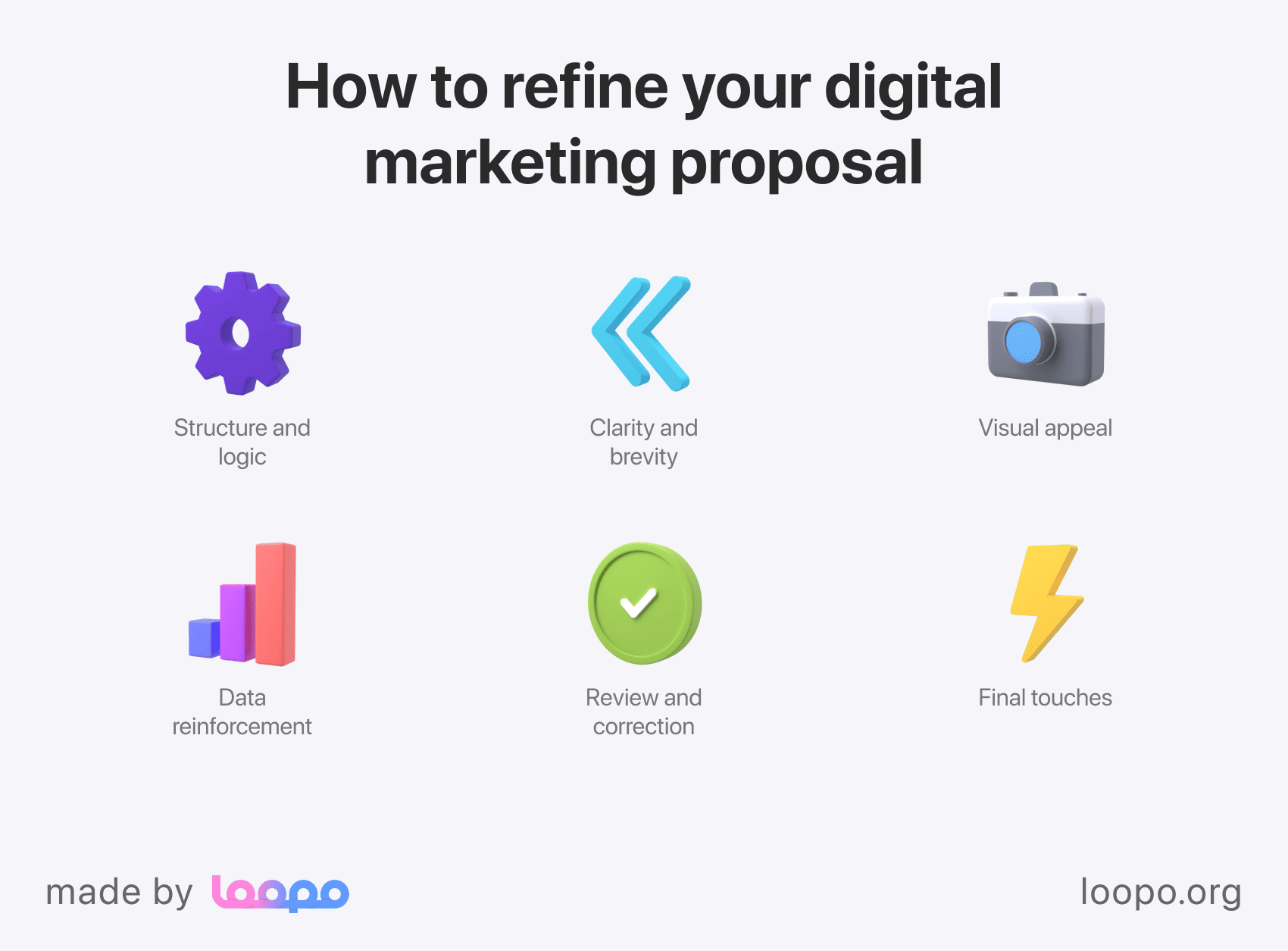
1. Structure and logic
Before diving into the details, it's essential to review the structure of your digital marketing proposal. It should be logical and consistent, allowing the client to follow your thoughts easily. Begin by reviewing the core components of the proposal: executive summary, objectives, market research, scope of work, strategy, budget, timeline, and team.
Make sure each section flows smoothly into the next. For example, you should move on to market research that supports these goals after setting goals. Each block should reflect your deep understanding of the client's needs and prove why you are the best choice for their business.
2. Clarity and brevity
Your pitch should be short and concise in digital marketing, where time is a resource. Try to avoid excessive terminology or confusing sentences. Instead, use simple but professional wording. Clarity in your presentation of ideas will allow your prospect to absorb information more quickly, which, in turn, can speed up the decision-making process.
Here are some plain tips to improve the clarity of your digital marketing proposal template: use simple words, ask questions, and avoid clericalisms.
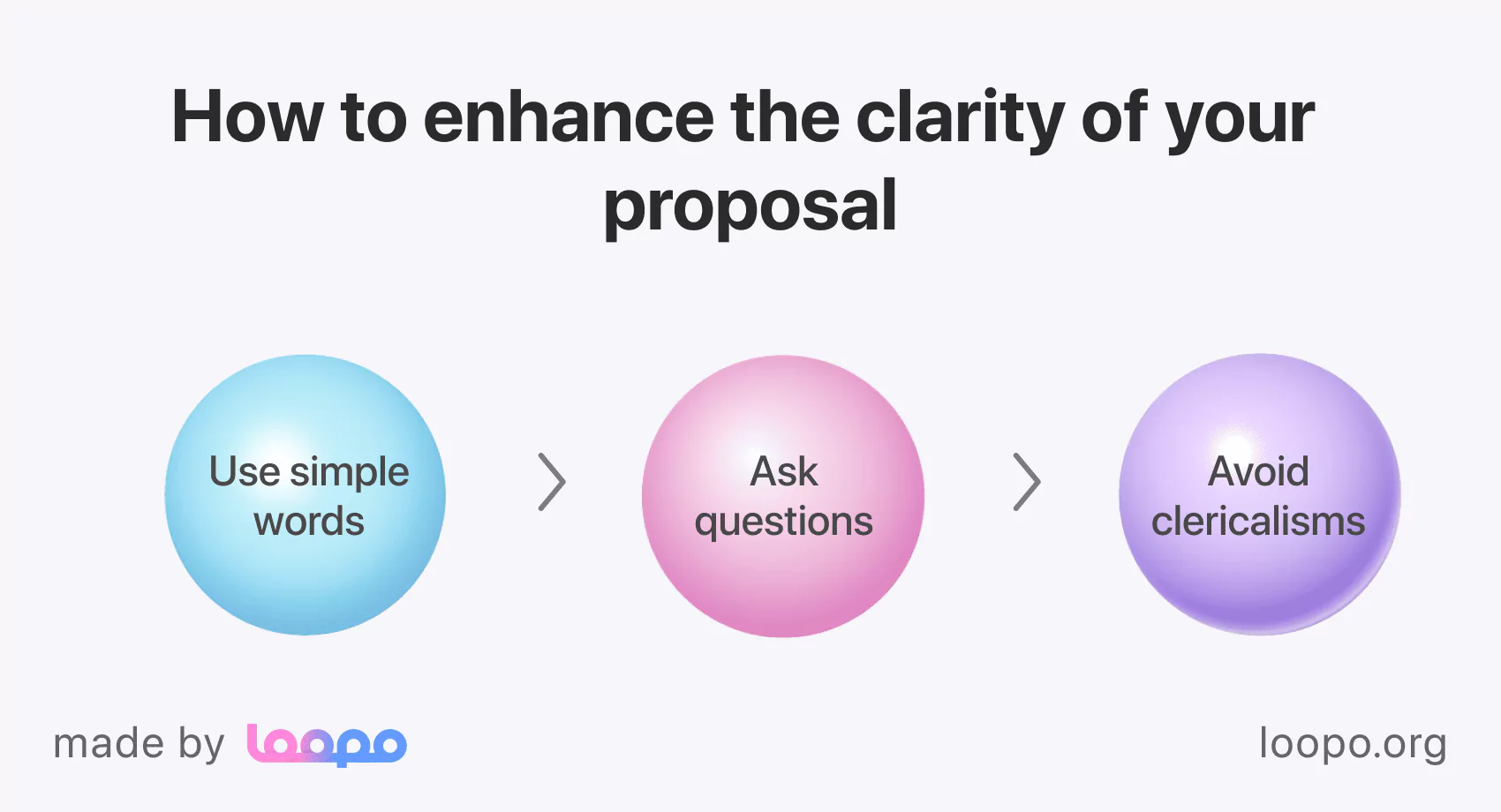
3. Visual appeal
Add visual elements that will make it more attractive and easier to understand. Graphs, charts, tables, and other visual elements can emphasize essential data and make complex concepts easier to understand.
Also, pay attention to the formatting. Use subheadings, lists, and highlights for critical points. This will help the reader to find the necessary information quickly. Bright colors and fonts can add creativity. However, the design should be understated and consistent with your company's brand.
4. Data reinforcement
In a digital marketing proposal, your ideas should be supported by facts and figures. Include statistics, research findings, or case studies demonstrating your expertise and previous projects' success. This data will strengthen your argument and show the client that you are not just a theorist but a practitioner with real achievements.
Don't forget to mention your experience in a specific field. This can be critical for a client as they are looking for a specialist who knows how to succeed in their niche.
5. Review and correction
Once you're done polishing, don't forget the importance of a review. Take the time to double-check your text for grammatical errors, stylistic inaccuracies, and logical gaps. Mistakes can lower your reputation in the eyes of the customer, so make sure that your message is effective and flawless.
Ask colleagues or friends to read your digital marketing proposal and provide feedback. They can spot things you've missed or provide new ideas for improvement.
6. Final touches
Do a final check before submitting your digital marketing proposal. Focus on the details: does the offer meet the client's requirements, do all the links perform, are the contact information correct.
Add a personal touch — for example, a small greeting or thank you for the opportunity to work together. This will make a positive impression and add a human dimension to your digital marketing proposal template.
Conclusion
In general, a digital marketing proposal is an engagement strategy that highlights your strengths and delivers the potential for collaboration. It is important to remember that every successful proposal combines analytics, a creative approach, and an understanding of the client's needs. Your main task is to convey value so customers feel confident choosing your team.
Ready to create a digital marketing proposal that turns potential customers into real partners? Our marketing team will help you every step of the way. Visit our blog for more insights, and contact us to get a great solution.





